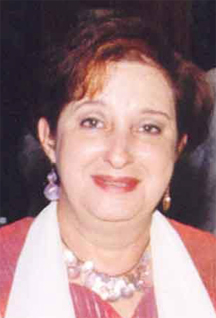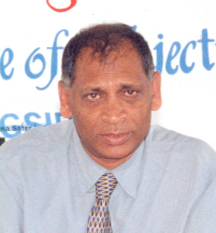Presidential Advisor on Governance Gail Teixeira has described the death of an East Coast Demerara woman following a botched abortion, as unfortunate, pointing out that a lot had been done since the passing of the Medical Termination of Pregnancy Act in 1995.
The Act, which became operational in early 1996, made the process of a woman terminating an unwanted child legal in Guyana.
Teixeira, who was the Minister of Health in 1995 and had piloted the bill through Parliament, told Sunday Stabroek that it is possible that a “lack of education” could have led to the young woman deciding to visit the office of a doctor who is not certified to do abortions.

Karen Badal, a young mother of two, according to her relatives, had visited the office of a Mon Repos doctor to have the pregnancy terminated, but became ill later and had to be rushed to the Georgetown Public Hospital (GPH) where she died on December 30, 2011. While the police have since launched an investigation into the incident it is not clear if the Medical Council of Guyana will be investigating her death as the President of the council, Dr Sheik Amir told Sunday Stabroek that an official complaint had not been lodged. Later efforts to contact Dr Amir to ascertain whether the council would be investigating the issue even without an official complaint proved futile.
The former health minister noted that the Medical Termination of Pregnancy Act was “carefully drafted” after layers of consultation with various stakeholders in the society.

The preamble to the Act states that it sought to “…reform the law relating to medical terminations of pregnancy, to enhance the dignity and sanctity of life by reducing the incidence of induced abortion, to enhance the attainment of safe motherhood by eliminating deaths and complications due to unsafe abortion, to prescribe those circumstances in which any woman voluntarily and in good faith wishes to terminate her pregnancy may lawfully do so and to provide for matters connected therewith.”
According to Teixeira the Act makes it clear that not only should the doctor who is performing the abortion be registered with the Medical Council but he also must be certified as one of the doctors who is authorized to terminate pregnancies.
The Act states that: “‘authorised medical practitioner’ means any person registered as a duly qualified medical practitioner under the Medical Practitioners Act 1991 and, being either a specialist in obstetrics and gynaecology with such experience as may be prescribed or a medical practitioner authorised in accordance with regulations made under section 16 to perform medical terminations of pregnancies.”
Secretary of the Medical Termination of Pregnancy (MPT) Advisory Board, Pamela Nauth told Stabroek News that there are currently 11 doctors who are authorized to do terminations of pregnancy and while most of them are based in Georgetown there are some located in other areas.
Third highest
Meanwhile, Teixeira told Sunday Stabroek that in the late ’70s and the ’80s deaths from botched abortions were listed as the third highest cause of maternal death in Guyana and it was for this reason the Act was eventually drafted and passed.
She said in those days women were visiting various “back street” establishments to have their pregnancies terminated and in many cases they ended up in the hospital haemorrhaging. While the case of Bahdal, who was four months pregnant at the time, is unfortunate, the former top health official pointed out that there has been no such reported death for some time.
However, this newspaper was told by senior medical officials that women still end up at public institutions, especially the GPH, suffering from the effects of abortions gone wrong. The official did note, however, that in recent times the statistics have shown that the number of women seeking medical treatment for this reason has dropped.
While the Act came into effect in 1996 it took several years for public hospitals to offer the service, and even today the GPH does not offer such a service. The GPH views medical termination as an added burden on its already heavy workload.
According to Teixeira before the Act was passed there was consultations with all stakeholders especially the religious community which had strongly objected to such an act being made law. The religious community was afraid that the Act would have represented abortion on demand and because of this concern the Act stipulates that a woman must be counselled before and after the abortion.
“The Minister shall make regulations for pre- and post-abortion counselling for any women seeking treatment regarding the medical termination of her pregnancy and, where appropriate, her partner; to facilitate such counselling such regulations shall provide for a waiting period of forty-eight hours after the woman has made a request for such medical termination of pregnancy,” the Act says.
In the end when the bill was put to the vote it was done on the basis of conscience not party, the first and only time this kind of vote was seen in the National Assembly, Teixeira said. The Governance Advisor suggested that women‘s organizations should do more sensitization about the Act and wondered whether members of those organizations are educated on the providions of the Act. She noted when the Act was being drafted the women‘s organisations played an integral role, but she was not sure if members who were not around then are fully aware of the Act.
Has the Act made it safer for women to have abortions? Former Minister of Health Dr Leslie Ramsammy responding to this question posed by Stabroek News in 2008 had answered yes, and pointed out that certified doctors were supervising the terminations in the public institutions. But on the other hand he had acknowledged that a number of uncertified medical practitioners and persons with no medical background were terminating pregnancies, often in unsafe environments.
The Act does not only stipulate that the doctor be certified to carry out the abortion but the facility at which it is done also has to be certified.
Back in 2008 among the concerns raised was the use of the drug Cytotec during unsupervised terminations. Ramsammy had said it was dangerous to use the drug unsupervised since this could and had contributed to maternal deaths in Guyana, yet many pharmacies across the country dispensed the drug without a prescription. Pharmacies today still sell the drug without a prescription.
Cytotec (misoprostol) is a synthetic prostaglandin (hormone-like substance), which reduces the production of stomach acid and protects the stomach lining. It is prescribed for people who take nonsteroidal anti-inflammatory drugs (NSAIDs), such as aspirin, to help prevent stomach ulcers.
The manufacturers warn that the drug causes uterine contractions that could lead to an incomplete miscarriage with the risk of bleeding, hospitalization, surgery, infertility, or even death. Despite this, however, some pharmacies sell this drug to pregnant women and women of child-bearing age.
Still functioning
Meantime, secretary of the Medical Termination of Pregnancy (MPT) Advisory Board Pamela Nauth told Sunday Stabroek that the board was functioning up to December 31, 2011 when its life expired and they are now awaiting word from the new Minister of Health, Dr Bheri Ramsarran. She said that even though the board is mandated to have nine members, currently there are only six following the death of its former Chairman, Fredrick Cox, the migration of one member and the resignation of another for work related reasons. She said that Attorney-at-law Sheila Chapman-Wong took over the mantle of the chairmanship following Cox’s death and the board has written to organizations in relation to members.
According Nauth the board has been very effective in its work in all regions in sensitizing the communities. Several years ago when the board first started its work even some doctors were not aware of the Medical Termination of Pregnancy Act, and they along with communities had to be educated. Nauth said the board has established sub-committees in all the regions except Region 8 and the members of those committees report to the board. While the board does not have its own office it comes under the Ministry of Health and holds its monthly statutory meetings at the ministry.
Nauth admitted with all the work the board has been doing women still continue to take risks by visiting the offices of uncertified doctors, and she said this was owing to various reasons and not just the lack of education on the Act. She named poverty and pride as other reasons for such dangerous decisions by some women.
And Nauth pointed out that once the pregnancy has passed two months, as was the case with Bhadal, there should have been two doctors present when terminating the foetus.
Annually the official figure for terminations stood between 4,000 and 6,000, but abortions are underreported in addition to many of the cases not being captured in the health data.
“Where a pregnancy sought to be terminated is of more than eight weeks duration and of not more than twelve weeks duration or the treatment for the termination of the pregnancy is by any lawful and appropriate medical preparation, then subject to the provisions of this Act, the treatment of such a pregnancy may be administered by an authorised medical practitioner and any assistant acting under such authorised medical practitioner’s directions…” the Act says.
However, the Act further states that such pregnancies should only be terminated:
(b) where, in the opinion of the authorised medical practitioner administering or directing the treatment –
(i) the continuance of the pregnancy would involve risk to the life of the pregnant woman or grave injury to her physical or mental health;
(ii) there is substantial risk that if the child were born, it would suffer such physical or mental abnormalities as to be seriously handicapped; or
(iii) on account of being a person of unsound mind, the pregnant woman is not capable of taking care of an infant;
(c) where the pregnant woman reasonably believes that her pregnancy was caused by an act of rape or incest and submits a statement to that effect;
(d) where the pregnant woman is known to be HIV positive; or
(e) where there is clear evidence that the pregnancy resulted in spite of the use in good faith of a recognized contraceptive method by the pregnant woman or her partner.
According to Nauth more women are now on family planning and are protecting themselves, and while the board would want to take credit for the reduction of cases of botched abortions it was a holistic approach that included education about HIV and other STIs that can be credited for the reduction. She said there are many positive things happening, but unfortunately these would not be highlighted and instead cases such as Bahdal’s would be made public.




